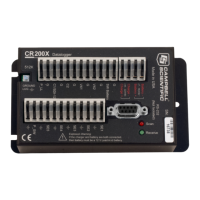Section 9. Programming
71
processing instructions that compress many common calculations used in
CR200(X) dataloggers.
These four elements must be properly placed within the program structure.
9.4 Numerical Formats
Four numerical formats are supported by CRBASIC. Most common is the use of
base 10 numbers. Scientific notation, binary, and hexadecimal formats may also
be used, as shown in TABLE. Formats for Entering Numbers in CRBASIC (p.
71). Only standard base 10 notation is supported by Campbell Scientific
har
dware and software displays.
Table 5. Formats for Entering Numbers in CRBASIC
Format Example Base 10 Equivalent Value
Standard 6.832 6.832
Scientific notation 5.67E-8
5.67X10
-8
Binary &B1101 11
Hexadecimal &HFF 255
Binary format is useful when loading the status (1 = high, 0 = low) of multiple
flags or ports into a single variable, e.g., storing the binary number
&B11100000 preserves the status of flags 8 through 1. In this case, flags 1 - 5
are low, 6 - 8 are high. CRBASIC EXAMPLE. Load Binary Information into a
Variable (p. 71) shows an algorithm that loads binary status of flags into a
LON
G integer variable.
CRBASIC EXAMPLE 2. Load binary information into a single variable
Public FlagInt
Public Flag(8)
Public I
DataTable (FlagOut,True,1000)
Sample (1,FlagInt)
EndTable
BeginProg
Scan (1,Sec)
FlagInt = 0
For I = 1 To 8
Flag (I) = IIF (Flag(I)= 0,0,-1)
If Flag(I) = true then
FlagInt = FlagInt + 2 ^ (I - 1)
EndIf
Next I
CallTable FlagOut
NextScan
EndProg

